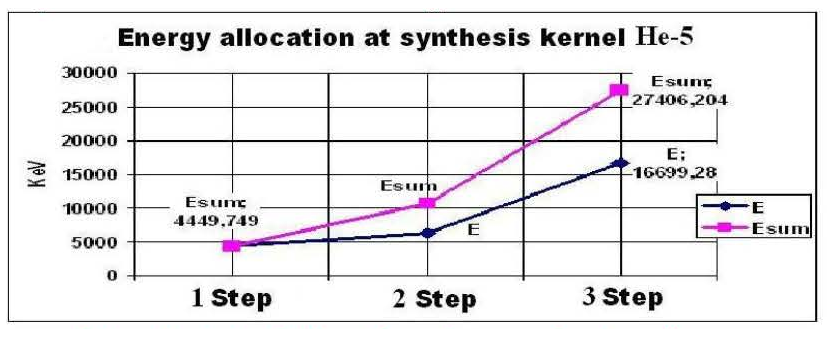The energy allocated at the first step of synthesis is equal
E1 = E2H2+E2H2 = 2224.749 KeV + 2224.749 KeV = 4449.749 KeV
At the second step there is one reaction of synthesis
21H+ 10n = 31H + 6257.426 KeV.
The energy allocated at the second step of synthesis is equal
E2 = E2H3 =6257.426 KeV.
At the third step there is one reaction of synthesis
31H+21H=52He + 16699.28 KeV.
The energy allocated at the third step of synthesis is equal
E3 = E2H3 =16699.28 KeV.
The sums of energies allocated in the previous steps can be defined under the formulas:
E1sum= E1=4449.749 KeV — for the first step.
E2sum= E1+E2=4449.749 KeV +6257.426 KeV=10706.924 KeV — for the second step.
E3sum= E1+E2+E3=4449.749 KeV +6257.426 KeV+16699.28 KeV=27406.204 KeV -for the third step.
Let’s make the table of allocation of energy at the synthesis of a kernel of helium 52He
(15) Table № T-3.2.
Allocation of energy at the synthesis of a kernel of helium 52He
According to table № T-3.2 we shall construct the schedule № G-3.1 describing the allocation of energy E in steps and total allocation of energy Esum.
The schedule of allocation of energy in steps E
And total allocation of energy Esum, at synthesis of a kernel of helium 52He.
(16) Schedule № G-3.1.
After construction of the schedule we move to the analysis of the received data and the schedule.
In this analysis a full chain of synthesis is made, considering all the nuclide and calculated allocation of energy for all kernels.
— A choice and the power analysis of chains of synthesis, kernels of atoms
And so, the program of the analysis is certain, we move to the following stage.
Let’s choose chains of synthesis from protons and neutrons up to the heaviest kernels limited by the periodic table with Z=110, A=272 and Z=111, A=272.
The chain was chosen by the rate of its maximal length and by the presence of data in table № A-1, for elements of this chain.
The chosen chain of synthesis (11H — a kernel with Z=111, A=272), for two kernels, is represented on schemes № S-3.2, № S-3.3, № S-3.4.
Chains of synthesis (11H — a kernel with Z=111, A=272): for three kernels — on schemes № S-3.7, № S-3.8; for four kernels — № S-3.9; for ten kernels — № S-3.10.
Chains of synthesis (11H — a kernel with Z=110, A=272) for two kernels are represented on schemes № S-3.5, № S-3.6.
Let’s disassemble a chain of synthesis for two kernels or nuclides
Variant — (11H — a kernel with Z=111, A=272) on schemes № S-3.2, № S-3.3, № S-3.4.

(17) Scheme № S-3.2.
(18) Table № T-3.3, a line 16.

(19) Scheme № S-3.3.
(20) Table № T-3.3, a line 15.



